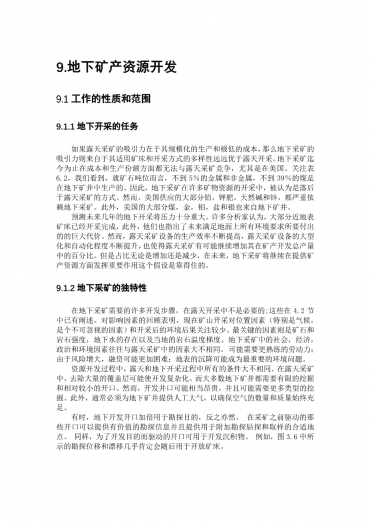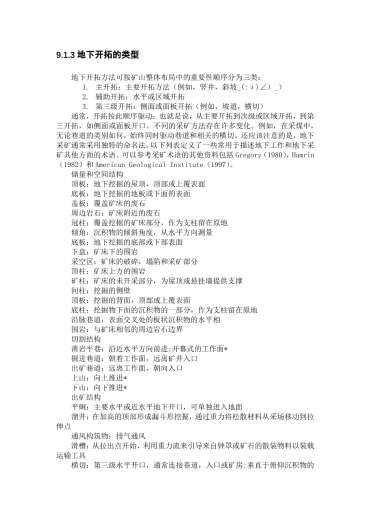9 UNDERGROUND MINE DEVELOPMENT
9.1 NATURE AND SCOPE OF THE TASK
9.1.1 Role of Underground Mining
If the appeal of surface mining lies in its mass production and minimal-cost capabilities, then the attraction of underground mining stems from the variety of ore deposits that can be mined and the variety of its methods to meet conditions that cannot be approached by surface mining. Underground mining cannot compete with surface mining today in its cost or share of U.S. miner~ production. Reviewing Table 6.2, we see that in terms of ore tonnage, less than 5% of metals and nonmetals, and less than 39% of all coal is produced in underground mines. Thus, underground mining is relegated to a secondary role for many commodities. However, the United States depends heavily on underground mining for most of its supply of lead, potash, trona, and zinc. In addition, much of its coal, gold, molybdenum, salt, and silver come from underground mines.
Predicting underground production in upcoming years is quite difficult. Many analysts argue that most of the near-surface deposits have already been mined. In addition, they point out the great expense of meeting all environ-mental requirements on the surface. However, the ever-increasing productivity of surface mining equipment and the greater ease with which surface mining equipment can be upsized and automated makes it more likely that surface mining will continue to increase as a percentage of our total production. Whether it increases or decreases, it is safe to assume that underground mining will continue to play an important role in supplying mineral resources in the future.
9.1.2 Uniqueness of Underground Mining
A number of development steps are required for underground mining that are not necessary in surface mining; these are outlined in Section 4.2. A review of the governing factors indicates that there is less concern for location factors (climate, in particular, is less a factor) and environmental consequences. The most critical factors are ore and rock strength, the presence of groundwater, and the rock temperature gradient in the locality. The social, economic~, political, and environmental factors in underground mining are often quite different from those in surface mining. A more skilled labor force may be required, financing may be more difficult because of increased risk,and subsidence may become the most important environmental concern.
The extent of access development required is also quite different. In surface mining, removal of significant amounts of overburden may complicate development. On the other hand, limited excavation and relatively small openings are necessary for most underground mines. However, the development openings may be considerably more costly on a tonnage basis, and more types of excavations may be required. In addition, underground mines normally must be provided with an artificial atmosphere as a means of ensuring that the quantity and quality of air are always adequate.
On occasion, underground development openings double for exploration purposes, and vice versa. Those openings driven in advance of mining can provide valuable exploration information and afford suitable sites for additional exploration drilling and sampling. Likewise, openings driven for exploration purposes can be utilized to develop the deposit. For example, the exploration shift and drifts shown in Figure 3.6 would almost certainly serve subsequently to open up the deposit.
9.1.3 Types of Underground Openings
Underground development openings can be ranked in three categories by order of importance in the overall layout of the mine:
1. Primary: Main openings (e.g., shaft, slope)
2. Secondary: Level or zone openings (e.g., drift, entry)
3. Tertiary: Lateral or panel openings (e.g., ramp, crosscut)
Generally, the openings are driven in this order; that is, from main development openings to secondary level or zone openings, to tertiary openings like lateral or panel openings. However, many variations exist with different mining methods. For example, in coal mining, the entries and the associated crosscuts are always driven at the same time, regardless of the category of the entries. It should also be noted that underground mining often employs a distinctive nomenclature. The following lists define a number of the terms commonly used to describe underground workings and other aspects of underground mining. Other sources that can be consulted for terminology of mining include Gregory (1980), Hamrin (1982), and American Geological Institute (1997).
Deposit and Spatial Terms
Back: Roof, top, or overlying surface of an underground excavation
Bottom: Floor or underlying surface of an underground excavation
Capping: Waste material overlying the mineral deposit
Country rock: Waste material adjacent to a mineral deposit
Crown pillar: Portion of the deposit overlying an excavation and left in place as a pillar
Dip: Angle of inclination of a deposit, measured from the horizontal; also pitch or attitude
Floor: Bottom or underlying surface of an underground excavation
Footwall: Wall rock under the deposit
Gob: Broken, caved, and mined-out portion of the deposit
Hanging wall: Wall rock above a deposit
Pillar: Unmined portion of the deposit, providing support to the roof or hanging wall
Rib: Side wall of an excavation; also rib pillar
Roof: Back, top, or overlying surface of an excavation
Sill pillar: Portion of the deposit underlying an excavation and left in place as a pillar
Strike


英语原文共 9 页


